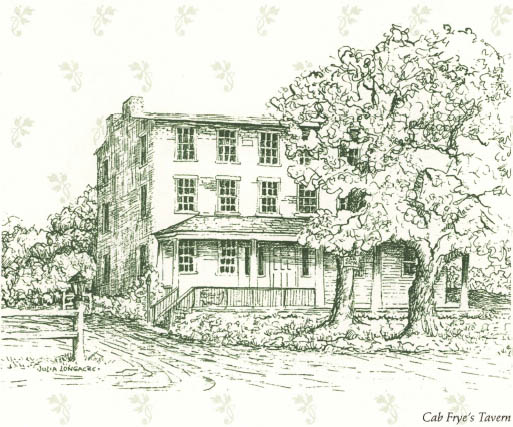

During the westward expansion of our young country, the going was very difficult until a system of roads was built along Indian trails and rutted thoroughfares. As these routes developed, economic prosperity tended to follow. The restaurants in this chapter are all inns, taverns, hostelries, and hotels that opened along the National Road, the Lincoln Highway, and other major routes as our countrymen traveled and traded.
US 30, CENTER SQUARE
ABBOTTSTOWN, PA 17301
717-259-9535
It’s not often that anyone, particularly a restaurant proprietor, is proud of the fact that he serves lumpy mashed potatoes. However, at The Altland House, the Lumpy Mashed Potatoes are considered a house specialty. Made from red potatoes, they’re a delicious accompaniment to many of the menu choices.
The menu here leans toward shrimp and crab, though there are selections to suit every appetite. Karen opted for the Margarita Shrimp, which consisted of jumbo shrimp sautéed in tequila and then served with Citrus Beurre Blanc amid field greens and grilled crostini. Debbie had difficulty deciding between the Parrot Bay Coconut Shrimp and the Chicken Napoleon but finally chose the chicken. It was a decision not to be regretted. Her chicken breast was layered with crispy won tons and lightly sautéed spinach, all of which was coated in Herbed Chicken Au Jus. It was as attractive and unusual as it was delicious, and the best part of all was the Lumpy Mashed Potatoes on the side!
After lunch, we remained in the Federal-style dining room to chat with owner Mike Haugh. He pointed out the murals of The Altland House and other town scenes on the walls and reminisced about his young life in Abbottstown. His mother, Betty, was once the town historian, so stories about the village come easily to him.
The town, founded in 1753 by John Abbett, was a full day’s travel for the Conestoga wagons heading west out of Lancaster. Because of this, several public eating and drinking houses came into being along the route. The establishment that sits today at the junction of US 30 and PA 194 was purchased in 1880 by Reuben Altland and flourished as an inn and tavern.
Other such establishments died out after the advent of the automobile, but this big hotel continued to do business. Mike’s mother, who grew up just a few doors down from the corner, began working as a waitress in the hotel’s dining room during her early teens. She commented many times that she would one day own the hotel, but Mike isn’t sure how seriously people took her statements. Chicken and Waffles were the specialties back then. Pictures on the walls of chicken pluckers knee-deep in feathers show just how popular those dinners were.
As World War II began, Betty went to work in a nearby factory. It was there that she met Mike’s father, a welder. In 1954, Betty’s prophecy was fulfilled when she and her husband purchased The Altland House. Shortly afterward, Mike’s father concocted his first recipe, Turtle Soup, which is still on the menu. The family continues to run the business today, with Mike at the helm and his son on board.
As our chat came to a close, we gazed across the wide wraparound porch to the cluster of original structures around the town square. Like them, The Altland House has stood the test of time.
 SALMON AND ROCKFISH NAPOLEON WITH LEMON GRASS AND CANDIED GINGER BEURRE BLANC
SALMON AND ROCKFISH NAPOLEON WITH LEMON GRASS AND CANDIED GINGER BEURRE BLANC 
Fish
6-ounce rockfish fillet
8-ounce salmon fillet
salt and pepper to taste
¼ cup clarified butter
¼ cup Chardonnay
Lemon Grass and Candied Ginger Beurre Blanc (see next column)
Preheat oven to 450 degrees. Slice rockfish into 3 pieces widthwise, then butterfly them open. Slice salmon lengthwise into 4 uniform pieces. Starting and ending with the salmon, stack the fish pieces in alternating layers. Lightly salt and pepper. Using butter and Chardonnay, lightly grease a baking pan. Place fish in pan and place in oven. Bake 10 to 15 minutes. Remove from oven and top with Lemon Grass and Candied Ginger Beurre Blanc. Suggested accompaniments are saffron risotto and steamed asparagus. Serves 2.
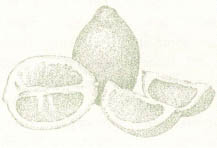
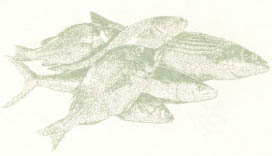
Lemon Grass and Candied Ginger Beurre Blanc
1 lemon grass bulb, smashed and chopped
2 tablespoons candied ginger, diced fine
1 teaspoon shallots, chopped
½ cup Chardonnay
½ cup rice wine vinegar
1 cup heavy cream
½ cup sweet cream unsalted butter
salt and pepper to taste
chives, diced fine
Place lemon grass, ginger, shallots, Chardonnay, and vinegar in a heavy-bottomed saucepan and heat on high; if you do not have a heavy-bottomed saucepan, lower heat to medium. Reduce until nearly dry. Add cream and reduce until thick. Remove pan from heat. Cut butter into 1-inch cubes and add cubes 1 at a time to saucepan, whisking until completely incorporated. Finish with salt and pepper and chives. Yields approximately 1 cup.

 CRACKED BLACK PEPPER-CRUSTED TENDERLOIN WITH BLUE CHEESE MUSHROOM RAGOUT
CRACKED BLACK PEPPER-CRUSTED TENDERLOIN WITH BLUE CHEESE MUSHROOM RAGOUT 
Beef
2 8-ounce cuts choice beef tenderloin
¼ cup cracked black pepper
¼ cup grape seed and olive oil with fresh herbs
1 clove garlic, diced
salt and pepper to taste
Blue Cheese Mushroom Ragout (see next column)
Crust outside edge of tenderloins with cracked pepper. Combine oil, garlic, and salt and pepper. Drizzle oil mixture over tenderloins. Grill tenderloins until they reach desired pinkness in center. Top with Blue Cheese Mushroom Ragout. Serve with garlic mashed potatoes and steamed broccoli. Serves 2.
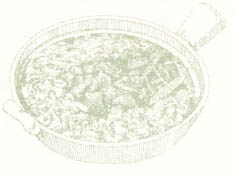
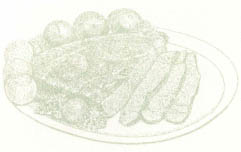
Blue Cheese Mushroom Ragout
¼ cup vegetable oil
1 large portabello mushroom, gills removed and sliced thin
4 large shiitake mushrooms, stemmed and sliced thin
10 medium button mushrooms, sliced thin
2 teaspoons garlic, minced
2 teaspoons shallots, chopped
½ cup brandy
½ cup veal or beef stock
½ cup heavy cream
½ cup blue cheese
salt and pepper to taste
4 sprigs fresh thyme, chopped
Heat oil in a medium saucepan, add mushrooms, and sauté for 2 to 3 minutes. Add garlic and shallots and sauté another 2 to 3 minutes. Deglaze pan with brandy and flame until alcohol is burned off. Add stock, cream, and blue cheese. Reduce until thick. Finish with salt and pepper and thyme.

113 EAST MAIN STREET
BOALSBURG, PA 16827
814-466-6241
Upon entering the town, you’ll see a sign proclaiming Boalsburg to be the home of Memorial Day. It seems that in 1864, several women decorated soldiers’ graves at local cemeteries. The custom then spread throughout the nation, becoming an annual event. This type of patriotism is still obvious on Boalsburg’s main street, where we found that many houses were draped with red, white, and blue swags, even though we visited in early August.
Long before the Memorial Day tradition started, the town served as a gateway to the West. Boalsburg was settled by the Scots-Irish in 1806, and its convenience as a stagecoach stop ensured prosperity for its residents. As the town grew, many of its houses were built from native stone. When the tavern was erected in 1819 by Colonel James Johnson, he, too, chose stone construction. The twenty-two-inch stone walls of Duffy’s Tavern are as solid today as when they were erected. Their thickness helps keep the indoor temperature of the busy restaurant at a comfortable sixty-eight or seventy degrees, even on hot summer days.
To the left of the entry hall is a large dining room with traditional appointments. The original cash drawer is there, tucked beneath the sill of what was originally an exterior window. On the first Sunday in December, the tavern’s annual eight-course feast is prepared in this room. Its enormous fireplace is used for much of the cooking. Just behind this dining room is another, more rustic in character. Cecil Aldin pictures decorate the walls, and a yoke light fixture hangs above. Across the hall is a formal dining room decorated with linens and wallpaper displaying bowls of fruit in the early American style. Located at the back of the restaurant is the Brick Room, which has long plank tables and a narrow, curved staircase leading to loft dining above. At one time, the large, second-floor banquet room was a ballroom with a hinged panel. After the dancing was over, the panel was lowered to separate the space into sleeping quarters for the guests, one side for the ladies and one for the men.
The tavern serves a wide variety of foods, from sandwiches to upscale entrées. The lunch menu, several pages long, continues to be available in the evening. The full-service dinner menu contains such choices as Filet Mignon stuffed with snow crab and Veal sautéed with garlic, mushrooms, and asparagus and topped with Swiss cheese and White Wine Sauce. We tried the Raspberry Brie, followed by the Tavern Salmon, which was stuffed with crabmeat, served on a bed of sautéed spinach, and topped with Béarnaise Sauce. They were both deliciously unusual in flavor. The dessert choices were tempting. After considering the Chocolate Framboise Cake and the Caramel-Topped Apple Pie, we opted to share a Napoleon. This puff-pastry confection, filled with caramel cream and topped with vanilla and chocolate icing, was lighter than air and the perfect ending to a marvelous meal.
Boalsburg is located just off Interstate 80 not too far from State College and Penn State University’s main campus. Step back in time after a Saturday of modern-day football and treat yourself to a meal at Duffy’s Tavern.

 VEAL PURNELL
VEAL PURNELL 
4 tablespoons clarified butter
2 5-ounce veal cutlets, tenderized
pinch of salt
pinch of pepper
¼ cup flour
2 cloves garlic, minced
1 cup mushrooms
10 asparagus spears, blanched
4 slices Swiss cheese
¼ cup white wine
½ cup chicken or veal stock
2 teaspoons lemon juice
1 to 2 tablespoons butter
Heat clarified butter over a medium flame. Season veal with salt and pepper. Dredge in flour and shake off excess. Lightly sauté veal for 1 minute on 1 side, then add garlic and mushrooms. Flip veal and add asparagus. When mushrooms are just cooked, turn heat to low and stack mushrooms and asparagus on top of veal and lay cheese over the whole stack. Deglaze pan with wine and reduce by ½. Add stock and lemon juice and mix well. Reduce again by ½. Using a spatula, lift veal “stacks” to 2 serving plates. Finish sauce by introducing butter to the remaining liquid a teaspoonful at a time. Pour sauce over veal. Serves 2.

 BOURBON- AND MAPLE-FLAVORED SWEET POTATOES
BOURBON- AND MAPLE-FLAVORED SWEET POTATOES 
10 medium sweet potatoes
1½ teaspoons salt
2 sticks unsalted butter, divided
¼ cup good bourbon
salt and pepper to taste
1 to 1½ tablespoons maple flavoring
Peel potatoes and dice them into ½- to ¾-inch chunks. Place potatoes in a stockpot, cover with water, and add 1½ teaspoons salt. Bring to a boil and cook potatoes until tender but still firm. Drain well, then lay potatoes in a single layer on a large baking tray. Bake at 350 degrees until completely cooked (baking helps remove the excess moisture). Whip potatoes with 1 stick of the butter and bourbon until all lumps are gone. Season with salt and pepper. Soften the remaining butter and combine it with maple flavoring in a mixer until well blended. Serve sweet potatoes hot with a generous dollop of the Maple Butter. Serves 10.


914 GRAVEL PIKE (PA 29)
PALM, PA 18070
215-679-9935
The short drive from Allentown into the countryside is well worth the anticipation. Winding our way along PA 29 on our way to Cab Frye’s for a late lunch, we thoroughly enjoyed the sunny fall afternoon. As we came within sight of this three-story brick building, we were struck by its profusion of flowers. Window boxes and flowerpots added to the festivity of the exterior decor. The interior was equally appealing. The whimsical accessories scattered throughout the building enhanced antiques such as cast-iron molds and coffee grinders.
We were seated in a light, airy dining room with cafe curtains and floral valences. The fresh flowers that were everywhere complemented the silver chargers. A fireplace with a rough-hewn mantel was centered on the far wall. Doorways with arched woodwork provided lovely transitions from room to room.
After many successful restaurant stops, chef Ed Galgon purchased Cab Frye’s Tavern in 1993. He and his wife, Tina, continue a tradition started many years ago. John Steinman and his family built this three-story brick building in 1830 along the gravel pike from Allentown to Philadelphia. It served as their home as well as a stagecoach stop. A century later, Elmer Trollinger purchased the building and the surrounding acreage. He successfully applied for a beer license and began to operate a tavern, growing on his own property most of the food he served. When Cab Frye and his wife, Betty, purchased the tavern in 1953, they began transforming the popular local taproom into a restaurant renowned for its fine food and cocktails. This tradition continued through subsequent owner Robert Eugster and right on to the tavern’s current keepers.
Today’s menu features continental dishes and seasonal highlights like wild game, seafood, fowl, and wild mushrooms. An extensive wine list complements the entrée selections. Dinner choices such as Scottish Lobster, sautéed with whiskey, curry, pineapple, and peaches, and Wiener Schnitzel, sautéed with Smoked Shrimp, will certainly draw us back for an evening meal.
We began our lunch with a salad of field greens topped with the flavorful house Garlic Vinaigrette, served with freshly baked Bread and Herbed Olive Oil for dipping. Both of us were drawn to the fish selections. Karen chose the Crab Cakes, served with Mango Salsa. She proclaimed them extremely delicious. Debbie did the same with her quiche of the day, a smoked salmon and sun-dried tomato combination. The creativity of the menu items and the superb presentation were a real treat.
As we wandered out to the parking lot, we took note of the delightful alfresco dining area. Lushly green, with a latticework entry, it made us muse about returning on a warm summer evening to renew our acquaintance with Cab Frye’s Tavern.

 cup blue cheese, crumbled
cup blue cheese, crumbled
2 tablespoons hot water
 cup mayonnaise
cup mayonnaise
 cup sour cream
cup sour cream
salt and freshly ground pepper to taste
¼ teaspoon Tabasco sauce
2 tablespoons sesame oil
1 tablespoon sesame seeds
1 tablespoon rice vinegar
20-ounce fillet of beef, trimmed
8 cups mixed baby greens
½ pound snow peas, trimmed and blanched
2 carrots, cut and blanched
Place cheese in a bowl. Using a fork, mix in the water, mayonnaise, sour cream, salt and pepper, and Tabasco to make dressing for the salad. In another bowl, combine sesame oil, sesame seeds, and vinegar. Marinate fillet about 20 minutes in this mix, turning once to allow fillet to absorb liquid. Grill fillet over a hot grill until it reaches desired doneness. Divide greens among 4 plates and garnish with snow peas and carrots. Slice beef, arrange on greens, then spoon dressing over top. Serve immediately. Serves 4.
Note: When purchasing the beef for this recipe, ask for the tail end of the fillet, which cooks more quickly, has more flavor, and is less expensive at the butcher shop than other cuts.


 PHYLLO TARTLETS WITH LIME CURD AND BERRIES
PHYLLO TARTLETS WITH LIME CURD AND BERRIES 
 cup plus 4 generous teaspoons sugar, divided
cup plus 4 generous teaspoons sugar, divided
1 teaspoon cornstarch
1 cups semisweet white wine
cups semisweet white wine
 cup fresh lime juice
cup fresh lime juice
1 teaspoon grated lime peel
½ cup egg substitute
4 sheets phyllo dough
2 tablespoons unsalted butter, melted
3 cups berries, washed and hulled
3 teaspoons extra-fine sugar
mint for garnish
To make lime curd, mix  cup sugar and cornstarch in a heavy saucepan until there are no lumps. Mix in wine, lime juice, and lime peel. Whisk in egg substitute. Whisk over medium heat about 7 minutes until mixture thickens and just begins to boil. Remove from heat and refrigerate.
cup sugar and cornstarch in a heavy saucepan until there are no lumps. Mix in wine, lime juice, and lime peel. Whisk in egg substitute. Whisk over medium heat about 7 minutes until mixture thickens and just begins to boil. Remove from heat and refrigerate.
To make tartlets, lightly butter the outside of 4 custard cups or ramekins. Stack phyllo sheets on a work board. Trim sides and cut 4 6-inch-square stacks from sheets. Lightly butter each sheet in each stack and sprinkle with 4 teaspoons sugar, turning each piece so corners are at different angles. Place each stack of sheets on an upside-down custard cup and press lightly into a bowl shape. Chill for 1 hour.
Preheat oven to 350 degrees. Place custard cups on a cookie sheet and bake about 20 minutes until phyllo turns brown. Let shells cool.
Divide lime curd evenly among shells. Top with berries and sprinkle with extra-fine sugar. Garnish with mint. Serves 4.
WEST OLD LANCASTER HIGHWAY
MALVERN, PA 19355
610-296-3637
Tucked away just off bustling US 202 sits the history-filled General Warren Inne. Originally named the Admiral Vernon Inn, it was built in 1745 to serve as a premier carriage stop for hungry travelers. In 1758, the inn’s name was changed to the Admiral Warren, after Admiral Peter Warren, a hero of the French and Indian War.
During the Revolutionary War, the inn was owned by John Penn, grandson of William Penn. John Penn was a well-known Loyalist, and the stage stop became a Tory stronghold where maps were drawn and strategies formed. Generals Howe and Cornwallis used those maps to navigate the valley en route to Philadelphia.
After the war, Penn sold the property to a German Seventh-Day Adventist by the name of Casper Fahnestock. During Fahnestock’s tenure, the thriving inn enhanced its reputation for clean lodging and excellent food. Many years later, Fahnestock’s great-grandson turned the inn into a temperance hotel, even going so far as to cut down the apple orchards on the property to prevent apple cider from being made and sold. In 1825, in an attempt to diminish ties to its Loyalist past, the inn was renamed to honor General Joseph Warren, the American hero of the Battle of Bunker Hill. Turnpike travel was at its peak during that time, and the inn housed a post office and served as a relay stop for the mail stagecoaches. When the Philadelphia and Columbia Railroad opened in 1831, the decline of the stage began. The last regular coach passed through in 1834.
One hundred and fifty years later, as the local area grew and developed, the current owners took great care to return the inn to its eighteenth-century elegance. In the large dining room where we were served, Oriental rugs covered the plank floor. Old-fashioned prints in antique frames hung on the walls, complementing the Colonial blue-and-white decor. White table linens, fresh flowers, and candles both on the tables and in the brass sconces on the walls gave the dining room a feeling of intimacy. This feeling was enhanced by the hurricane lanterns placed in each of the deep-set windows all along the length of the inn.
The very appealing luncheon menu included choices such as Louisiana Snapper Soup, Smoked Pork Foccacia Sandwich with a sauce of fennel, green olives, and tomato, and Pan-Roasted Beef Tenderloin Medallions, served hunter-style (in a brown gravy). The Pan-Fried Shrimp Dumplings, served in a Ginger Demi-Glace and accompanied by Oriental Vegetable Slaw, caught Karen’s eye. The slaw was crunchy and flavorful; the shrimp were innovative and appealing. The day’s special, Scrambled Egg and Truffle Crepes, served in a Mornay Sauce, tempted Debbie. Yum, yum, and again yum. Authentic Shortcake followed—not pound cake or angel food cake, but biscuit-style cake with fresh berries and cream. Karen finished it with a smile on her face, proclaiming, “I haven’t had Shortcake like this since I left England,” Maybe the inn is a Tory stronghold yet.

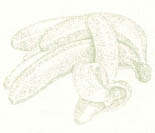
 BANANAS FOSTER
BANANAS FOSTER 
½ cup light brown sugar
2 tablespoons butter
¼ cup banana liqueur
1 banana, peeled and diced large
4½ teaspoons rum
2 large scoops vanilla ice cream
Place sugar and butter in a wide, shallow frying pan over medium heat and melt sugar mixture until it bubbles. Add banana liqueur and mix to combine. Add banana, stirring to coat. Add rum. If you are cooking with gas, tilt pan toward flame to ignite alcohol; otherwise, use a lighter to ignite. Continue to cook until flame goes out. Place ice cream in 2 serving bowls. Pour banana topping equally over each and serve. Serves 2.

 PORK TENDERLOIN DIJONNAISE SHIITAKE
PORK TENDERLOIN DIJONNAISE SHIITAKE 
2 4- to 5-ounce pork tenderloins
2 tablespoons butter
½ cup flour
3½-ounce package shiitake mushrooms
1½ teaspoons Dijon mustard
1 tablespoon scallions, sliced
1 teaspoon onion or shallots, minced
3 tablespoons white wine, chicken broth, or water
6 tablespoons heavy cream
6 tablespoons brown sauce
Clean pork of excess fat and remove the silver skin. Cut pork into 1-inch medallions; pound medallions flat. Place butter in a sauté pan over medium heat and allow to foam. Dredge pork in flour and sauté until golden brown on both sides. Remove pork from pan. Add remaining ingredients to pan and bring to a simmer. Reduce sauce to desired consistency. To serve, spoon sauce onto 2 plates and place medallions on top. Spoon additional sauce over top. Serves 2.

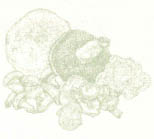
14 EAST MAIN STREET
LITITZ, PA 17543
717-626-2115
John Augustus Sutter was commonly known as General Sutter because of his involvement in the Mexican War, during which he owned a large parcel of land in the Sacramento Valley. However, he’s better remembered for a discovery that changed the future of many people—gold! Unfortunately for him, he was unable to keep his findings a secret. Men in search of a fortune—called “Forty-niners” because of the year they went west—swarmed his property, trampled his crops, and left his livestock and land in ruin. Ironically, their quest of gold left him nearly bankrupt. In ill health, he moved from California to the quiet streets of Lititz, Pennsylvania.
Sutter built his home across the street from the town’s hotel. He hoped to provide his three grandchildren the benefits of a fine Moravian education and to cure himself in the town’s mineral springs. In his honor, the local inn—founded by the Moravian Church in 1764 as the Zum Anker, or “Sign of the Anchor,” and later called the Lititz Springs Hotel—was renamed the General Sutter Inn.
Since its inception, the inn has been regarded as one of the finest in Pennsylvania. In 1803 and again in 1848, it underwent renovations that created the comely three-story brick building of today. The lobby is decidedly Victorian, with settees on either side of the fireplace and a portrait of General Sutter above the mantel. Details such as the plaster molding prettily patterned on the ceiling add to the decor.
The General Sutter Inn houses three separate restaurants. Pearl’s Victorian Bar provides spirits of all types, as well as a tavern menu. The Zum Anker Cafe serves hearty breakfast items such as Cornmeal Pancakes and Grilled Pecan Sticky Buns. The many unusual breakfast choices include Eggs Florentine (poached eggs with Canadian bacon and sautéed spinach, served on an English muffin and topped with Mornay Sauce) and Rolled Pancakes, Pennsylvania Dutch-style, stuffed with a variety of fruit fillings. The 1764 Restaurant, named for its founding date and appointed in Federal-style decor, offers a pleasing combination of colonial heritage and a modern menu.
Karen had the Ostrich in Raspberry-Garlic Reduction. Debbie honored General Sutter’s Western heritage, choosing the Bison served in a sauce of cumin and pine nuts. Both entrées were served with Flavored Mashed Potatoes, Baby Carrots, and Broccoli Spears. The presentation of the meals, complete with orchid-and-rosemary garnish, was equaled by their flavor.
It had been a long day by the time we arrived at the inn, so we ended our flavorful meal by soothing ourselves with chocolate. The Bailey’s Cake was a luscious chocolate layer cake with a layer of Bailey’s Irish Cream Mousse. We also tried the Chocolate Gold, a fudge torte with a layer of Chocolate Gateau, served in a thin chocolate crust accented with gold leaf. Both were certainly worth every calorie!

 DRIED SOUR CHERRY QUINOA PILAF
DRIED SOUR CHERRY QUINOA PILAF 
2 cups quinoa
½ cup butter
2 tablespoons shallots, chopped
½ cup dried sour cherries
½ cup cherry wine
4 cups chicken stock
salt and pepper to taste
Sauté quinoa in butter until lightly browned. Add shallots and cherries. When mixture is thoroughly heated, deglaze with cherry wine. Add stock and let simmer until liquid is absorbed and quinoa is tender and moist. Adjust salt and pepper. Serves 12.

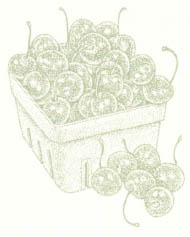
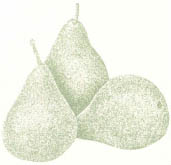
 BOSC PEAR ARMAGNAC GRANITA
BOSC PEAR ARMAGNAC GRANITA 
2¾ cups water
1½ cups sugar
½ cup lemon rind, grated
1 cup Armagnac
5 quarts Bosc pears, peeled and seeded
Bring water, sugar, lemon rind, and Armagnac to a boil in a saucepan. Allow to simmer for 5 minutes until a syrup consistency is obtained. Remove from heat. Purée pears in a food processor. Add pears to syrup mixture and thoroughly combine. Line a small roasting pan with clear wrap. Spread mixture in pan, then freeze. When mixture is frozen, cut or break into pieces, return to food processor, and purée until smooth. Repack slush mixture in a plastic container and refreeze until needed. Scoop and serve. Serves 16.

½ cup clarified butter
2 10-ounce trout, deboned but with head and skin still on
pinch of salt
pinch of pepper
¼ cup lemon juice
1 cup white wine, divided
¼ cup water
2 pinches of saffron
½ cup fish or chicken stock
¼ cup heavy cream
2 tablespoons butter, dredged in flour
Coat a small baking sheet with the melted butter. Season the inside of the trout with salt and pepper. Place trout on baking sheet by spreading the sides apart, skin sides up. Combine lemon juice, ¼ cup of the wine, and water; ladle over length of trout. Place in a preheated 400-degree oven for approximately 10 minutes. While trout is baking, pour remaining ¾ cup wine into a small skillet. Heat on medium. Add saffron. Allow saffron to steep slightly, then add stock, followed by cream and butter dredged in flour. Swirl 1 to 2 minutes until a glassy, rich sauce is created. Remove from heat. When trout is done baking, skin will begin to bubble slightly; remove from oven. Using tongs, grasp trout by the head and slowly peel backwards to remove head and skin. The fillets are now easily separated into right and left halves. Place hot fillets in an X pattern on each of 2 plates and pour warm saffron sauce over the top. Serves 2.

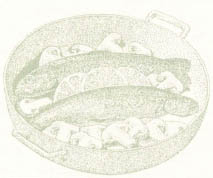
7712 SOMERSET PIKE (PA 985)
JENNERSTOWN, PA 15547
814-629-9220
For over seventy years, Green Gables Restaurant has served hungry diners traveling the Lincoln Highway. Opened as a roadside sandwich stand by James Stoughton in 1927, it received national recognition during its second year of operation, when it was awarded second place in the Rockefeller Wayside Stand Competition. Its simple menu of Chicken Salad Sandwiches and Angel Food Cake was so popular it soon undertook a series of expansions to accommodate its growing number of visitors. The first was the Hannah Sellers Dining Room, followed by three glass-enclosed terraces. The addition of the Tuscany Room in 1970 helped make Green Gables the full-service restaurant it is today.
Never at a loss for ways to expand Green Gables’ clientele, James Stoughton announced to his family that he intended to add a theater in the backyard. Housed in a gristmill that was relocated through the snow log by log to its present site, the Mountain Playhouse opened in June 1939. It presents a variety of productions from comedies to drama to musical entertainment.
Green Gables’ entrance remains very similar to what it was all those years ago. The original white clapboard building is still distinguishable from the additions, which were done in stone. Inside, the slate floors, rough-hewn beam ceilings, and stacked-stone walls are engagingly primitive. Enormous statues reminiscent of ancient Greece, garnered from the estate of steel magnate Charles Schwab, now serve as columns in the Terrace Dining Room.
We were seated window-side, which allowed us a view of the beautifully landscaped grounds. Tall evergreens stood on the banks of the creek as it meandered toward Stoughton Lake. It would have been easy to take in the atmosphere indefinitely, but we managed to focus on the menu long enough to order. It wouldn’t be a visit to Green Gables without sampling the Chicken Salad, which was delicious in its simplicity. Accompanied by fresh fruit and Apple Walnut Bread with Cinnamon Butter, it was a good choice for a summertime lunch. Karen tried the Potato-Leek Soup and found it thick, creamy, and flavorful. She followed that with the Salmon Croquettes, served in Dill Sauce. The croquettes were well seasoned and moist.
After lunch, we, like many of the other guests, wandered through Green Gables’ nooks and crannies to admire the artwork and the impressive collection of antique glass, china, and pottery. We also explored the Tuscany Room, an expansive dining room. James Stoughton designed the punched-copper lighting himself. Massive oak trees located in each corner of the room were the original survey markers on the family farm. The large fireplace and the window with vines growing across it add to the rustic mood.
Regardless of where you’re seated—in the Tuscany Room, the Hannah B. Sellers Dining Room, or the Terrace Dining Room—your experience at Green Gables is sure to be unique.

 SALMON CROQUETTES
SALMON CROQUETTES 
2 14¾-ounce cans salmon
2 eggs
1 tablespoon heavy cream
½ stalk celery, diced fine
½ teaspoon dill
salt and pepper to taste
3 slices bread, diced fine
1 to 1½ cups dry breadcrumbs
Drain salmon and clean it of bones and skin. Place salmon in bowl. Add eggs, cream, and celery and mix by hand. Add dill, salt and pepper, and bread to bind ingredients. Form mixture into meatball-size portions and roll in breadcrumbs. Deep-fry croquettes. Drain and serve with cream sauce of your choice. Yields 8 croquettes.

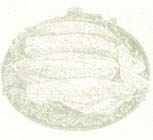
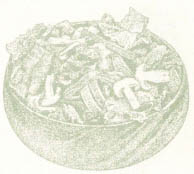
 BLUE CHEESE DRESSING
BLUE CHEESE DRESSING 
4 cups mayonnaise
1 pound blue cheese, crumbled
¼ cup sugar
¼ cup buttermilk
½ tablespoon salad oil
½ tablespoon vinegar
¼ teaspoon white pepper
Combine ingredients in a large mixing bowl. Store in refrigerator in an airtight container. Yields 5 to 6 cups.

220 MAIN STREET
SAXONBURG, PA 16056
724-352-4200
What do the Brooklyn Bridge and the village of Saxonburg, Pennsylvania, have in common? On the surface, it seems that a hamlet that is a bastion of turn-of-the-century Americana and an urban bridge renowned for its cutting-edge technology would be worlds apart. What links them is John Roebling.
Originally from Mulhausen, Germany, Roebling founded Saxonburg in 1832 on a 1,583-acre parcel purchased for $2209.50. He intended to create a German community here in America whose economic support would come from agriculture and light manufacturing. Today, Saxonburg is still much as its founder envisioned.
An engineer by education, Roebling labored in his Saxonburg workshop to develop and patent the wire-cable suspension for which the Brooklyn Bridge is famous. His bridge designs using this technology led to his fame and fortune and eventually forced him to move his cable works from Saxonburg to New Jersey for better transportation access.
Thanks to its fresh air and uncluttered countryside, Saxonburg became a weekend retreat for wealthy Pittsburghers escaping the effects of that city’s industrial boom. Hotel Saxonburg was one of the town’s most popular destinations. In its early years, the hotel was known as the Vogley House. In 1863, it became the Union Hotel. Francis Laube later purchased the structure and renamed it Laube House, a name that remained until the late 1800s.
Today, the hotel’s whitewashed exterior hints at what’s inside. The dining room to the right of the entry hall has tin-tile ceilings and painted plank walls. The old nails used to construct those walls are still visible. Pictures from Saxonburg’s early days line the walls, in and among farm implements from previous eras. Across the way, burgundy wallpaper and a wooden ceiling create an entirely different but equally appealing dining atmosphere.
The day we visited, the town was anxiously awaiting its annual Fireman’s Parade later in the afternoon. Chairs and blankets already lined Main Street as we pulled up for lunch. The stone steps and leaded-glass door beckoned us into the hotel, where we enjoyed choosing from a wide variety of luncheon items, including at least six soups. One of the more unusual entrée selections, the Crepe Alex, stuffed with shrimp, proved very good and the perfect size for lunch. For dessert, Karen tried the exotic Fried Ice Cream, while Debbie chose the Strawberry Shortcake, thus bringing an all-American lunch to an appropriate close.

 SEAFOOD PASTA
SEAFOOD PASTA 
¼ cup garlic butter
8 medium shrimp, peeled and deveined
½ cup scallops
8 fresh mussels (meat only)
¼ cup clams, chopped
2 to 4 tablespoons clam juice
½ cup heavy whipping cream
salt and pepper to taste
1 pound fettuccine, undercooked
2 tablespoons Parmesan cheese, grated
chopped parsley for garnish
Melt garlic butter in an 8-inch sauté pan. Add seafood and clam juice. Sauté slightly until well mixed; be careful not to overcook. Add cream and salt and pepper; cook to reduce by ½. Fold in pasta and toss while adding cheese. When fettuccine is heated through, transfer to serving plates and garnish with parsley. Serves 2.

 MUSTARD GRILLED CHICKEN
MUSTARD GRILLED CHICKEN 
1 cup Dijon mustard
1 tablespoon pepper
2 tablespoons olive oil
2 tablespoons white wine
2 boneless chicken breasts
Combine mustard, pepper, oil, and wine in a covered container to make marinade. Shake to mix well. Coat chicken breasts with marinade. Cover and marinate overnight. Broil or grill breasts 10 to 15 minutes until they are no longer pink in the center, turning at least once. Serves 2.

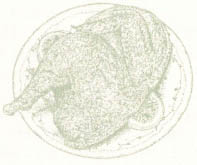
136 MARKET STREET
LEWISBURG, PA 17837
570-523-7800
The Lewisburg Hotel sits majestically on the main street of town. Built in 1834, accessible to the Pennsylvania Canal, the Old East-West Turnpike, and two major railroads, the hotel provided accommodations for generations of travelers. It was also home to the first president of the University of Lewisburg (now Bucknell University). The school’s first graduation exercises were held here in 1851. In attendance at the commencement were United States senator Simon Cameron and James Buchanan, who went on to become the fifteenth president of the United States. Every governor of Pennsylvania from 1831 to 1901 is said to have been a guest here. Notable people visiting the hotel after the turn of the century included sports figures Jim Thorpe, John McGraw, and Christy Mathewson, poet Walt Whitman, and opera diva Marian Anderson. During the 1930s, 1940s, and 1950s, many of the nation’s popular bands performed here.
The hotel was purchased by William Cameron after the Civil War, and the doors were closed for two years of renovations. For the next sixty years, the hotel was known as Cameron House. It was closed again in 1993, when it was purchased by Norman and Nancy Buck. Restored to its original grandeur, it reopened in 1997. The Lewisburg Hotel is the only old hotel in this community to have withstood changes in lifestyle and the wear and tear of time.
During our visit, we were charmed by the Victorian-style floral carpeting and coordinated wallpaper and the magnificent woodwork gleaming in the soft light, which created the effect of a library in two of the main dining rooms. In the third, named in honor of Senator Cameron, guests eat in a Victorian parlor atmosphere. The bar is a comfortable respite full of gleaming oak and capped off by a tin tile ceiling.
In the quiet atmosphere of the Governor’s Room, we perused the luncheon menu. Karen chose the Cucumber Dill Sandwich, served on toast, while Debbie enjoyed a sizable bowl of Potato Bacon Soup. Although guests around us sampled a variety of items, the Broccoli Cheddar Quiche and the Ham and Swiss Wrap were overwhelmingly popular.
The delightful town of Lewisburg has many restored buildings for visitors to enjoy. In its regal forest green with cream and burgundy trim, the Lewisburg Hotel again offers solace for another generation of weary travelers.

12 ripe plum tomatoes, quartered
2 red onions, sliced thin
6 cloves fresh garlic, chopped fine
1 cup fresh basil, cut into thin strips
2 cups virgin olive oil
1 cup balsamic vinegar
fresh-baked Italian bread, grilled
4 slices bucchini (fresh buffalo mozzarella cheese)
Parmesan cheese
In a large salad bowl, combine tomatoes, red onions, garlic, and basil. Mix gently but thoroughly. Emulsify oil and vinegar; add to tomato mixture and toss. Place on grilled bread, top with mozzarella, sprinkle with Parmesan, and serve. Serves 4.

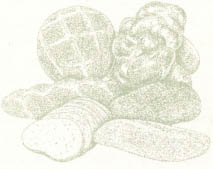
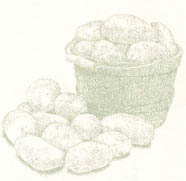
 STEAK AND POTATO SALAD
STEAK AND POTATO SALAD 
8-ounce New York strip steak
½ cup Italian dressing
2 to 3 cups fresh greens for salad
½ cup green bell pepper, diced
½ cup onions, diced
1 plum tomato, sliced
½ cup potato, diced and fried
½ cup Monterey Jack cheese, grated
Marinate steak in Italian dressing for 30 minutes at room temperature. Grill steak to medium-rare and slice thin. Place fresh greens on a plate. Toss peppers, onions, tomato, and potato and place on top of greens. Add steak on top in a circular pattern. Top with cheese and serve. Serves 1.

US 30 AND PA 31
BEDFORD, PA 15522
814-623-2250
Although it has operated as a tavern since its construction in the 1760s, Jean Bonnet’s public house didn’t officially receive a license until the third Tuesday in October 1780. The license read that the “Petitioner Lives at the Fork of roads leading to Fort Pitt and the Glades.” This was the junction of Old Forbes and Burd Roads, today’s US 30 and PA 31.
Records of the property prior to the tavern license show a title transfer of 690 acres from the William Penn family to Hans Ireland, a land speculator. In 1762, the property was transferred to Robert Callender, who was an Indian scout, a deputy for troop supplies, and eventually a scout for General George Washington. The tavern was built during Callender’s tenure. Jean Bonnet and his wife, Dorothy, purchased the building in 1779. In mid-1794, with the Whiskey Rebellion gaining momentum, farmers met at Bonnet’s to protest the federal excise tax on whiskey. Eventually, George Washington had to call in troops in an attempt to squelch the mounting dissatisfaction.
Today’s tavern is in many ways similar to Bonnet’s establishment of old. The native stone walls and enormous chestnut beams are still there. Barrels and other memorabilia are gathered around a huge fireplace, which smelled pleasingly smoky during our visit. The quilts hanging throughout the dining rooms provide additional colonial ambiance, as do the twig chairs and wooden furniture. The menu is, no doubt, broader than it was all those years ago. The choices today range from Roasted Duck to Stir-Fry to Vegetable Lasagna.
Comfort food was definitely in order on that incredibly rainy Sunday afternoon. Described as a “Bedford County favorite,” the Turkey and Waffles on the brunch menu certainly fit the bill. The entrée was preceded by a salad, served with a French-based Poppy Seed Dressing that included pieces of carrots and beets. It was as tasty as it was unusual. The warm, creamy entrée featured bite-size turkey ladled over a Belgian-style waffle. The waffle was light and fluffy and would have been as delicious with syrup as it was with the creamed turkey. The traditional dessert offerings included Apple Pie, Cherry Pie, Pecan Pie, and Oatmeal Pie.
Just off the Pennsylvania Turnpike, the Jean Bonnet Tavern is ready to cater to weary travelers just as it has served them since the late 1700s. A stop here certainly refreshed us. It also gave us insight into the long-popular all-you-can-eat chicken and waffle dinners that used to be served at so many of the restaurants featured in this book.

 OATMEAL PIE
OATMEAL PIE 
2 eggs
¾ cup white Karo syrup
½ cup butter, melted
½ cup white sugar
½ cup brown sugar
¾ cup oatmeal
1 cup evaporated milk
1 cup shredded coconut
1 teaspoon vanilla
9-inch pie shell, unbaked
Blend eggs, Karo, butter, white sugar, and brown sugar in a medium-sized bowl for 3 minutes. Add oatmeal and evaporated milk and mix for 1 more minute. Add coconut and vanilla and blend well. Pour into pie shell. Bake at 350 degrees for 30 to 40 minutes, until a knife inserted in the center comes out clean. Serves 8.

 HOUSE DRESSING
HOUSE DRESSING 
12-ounce bottle French or other Catalina-style dressing
½ tablespoon poppy seeds
 cup fresh beets, cooked and diced
cup fresh beets, cooked and diced
2 pickled eggs, diced
Combine all ingredients in a large mixing bowl. Yields 2 cups.

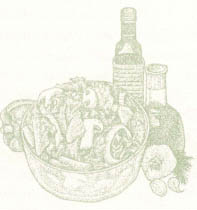
10 WEST FERRY STREET
NEW HOPE, PA 18938
215-862-2300
In 1722, by act of the General Assembly of Pennsylvania, John Wells was licensed to erect and keep a ferry on the banks of the Delaware River on land previously occupied by the Lenni-Lenape Indians. In 1727, he was licensed to keep a tavern. Thus began the Ferry Tavern at the corner of South Main and Ferry Streets. Wells was looked upon as the founder of New Hope. As the community grew, the tavern prospered. Today, it survives as a fine example of the colonial habit of wrapping additions around original buildings.
About a hundred years after the Ferry Tavern was licensed, the name was changed to The Logan Inn. At that same time, a metal Indian was installed above the roof. There are many different accounts of that event. However, the one that seems to be the most popular is that a Lenni-Lenape chief who was acclaimed for his kindness to white settlers developed a close friendship with James Logan. The chief and Logan, who was Williams Penn’s secretary, became blood brothers. Indeed, as a sign of respect, the chief took Logan’s name. The metal Indian remained above the inn for fifty years and was depicted in many woodcuts during that period. Now a town landmark, it can be seen on the lawn of the local historical society’s museum, which faces the inn.
A tavern is located in the oldest part of the building. Its stone walls, original fireplace, and antique wood paneling give the room a warm, friendly atmosphere. Guests enjoy looking at the beautiful murals that were discovered during renovations and then restored to their former glory.
There are two additional dining rooms at the inn. The Colonial Dining Room, decorated in cream and colonial blue, has wooden furniture, pewter wall sconces, and abundant candlelight. On the day we visited, lunch was being served in the Garden Dining Room. A light, airy room next door to the tavern, it shares one of the original building’s beautiful stone walls. The high, arched ceiling and the many floral stained-glass windows serve to make you feel like you’re still outdoors. Along one side of the room is a truly fascinating stained-glass wall created by a local artist.
The Logan Inn offers a wide range of choices for lunch. We could have selected from twelve different sandwiches, ranging from Grilled Turkey Sausage with Peppers and Onions to Chicken Salad Maison, which contained morsels of chicken breast with celery and apples. There were ten different salads. Karen almost opted for the Garden Rotini Pasta Salad, which combined tricolored pasta, red peppers, green peas, scallions, and pine nuts in creamy Basil Sauce. Ultimately, we both selected the house specialties—a cold soup de jour followed by the quiche of the day. The creamy Dill Cucumber Soup was perfect on that hot summer day. It was followed by light, fluffy Cheddar and Broccoli Quiche with Roasted Red Peppers. The salad that accompanied the quiche was crisp and tasty.
All in all, it was a delicious sampling from the fifth-oldest inn in America. The Ferry Tavern may be long gone, but the Logan Inn remains to carry on a 275-year tradition of serving appetizing food in comfortable surroundings.

 CRAB CAKES
CRAB CAKES 
1 tablespoon scallions, chopped
1 tablespoon red bell pepper, diced
1 tablespoon butter
1 pound lump crabmeat
1 tablespoon parsley, chopped
½ cup breadcrumbs
1 teaspoon Dijon mustard
1 teaspoon Old Bay seasoning
1 teaspoon Worcestershire sauce
½ cup mayonnaise
tartar sauce or cocktail sauce
Sauté scallions and red peppers in butter for about 3 minutes. Combine with remaining ingredients. Shape into crab cakes using an ice cream scoop. Bake in a preheated 425-degree oven for 5 minutes until golden brown. Serve with tartar sauce or cocktail sauce. Yields 6 crab cakes.
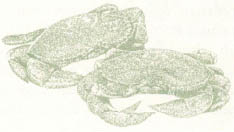

 CHICKEN LOGAN AU PECHE
CHICKEN LOGAN AU PECHE 
2 large chicken breasts, deboned, skinned, and split
salt and white pepper to taste
2 tablespoons butter
1 tablespoon brown sugar
¼ teaspoon fresh ginger root, grated (or ½ teaspoon minced candied root)
1 ripe peach, peeled, pitted, and sliced
1 tablespoon Major Grey’s Chutney (optional)
flour for dusting
1 egg, beaten
¾ cup white breadcrumbs
vegetable oil
Pound chicken breasts between sheets of waxed paper as thin as possible without tearing. Season with salt and pepper. Melt butter in a small saucepan. Add brown sugar and ginger root, stirring until sugar is dissolved. Add peach slices and simmer for 1 minute. Cool. Add chutney, if desired. Place peach slices on each flattened breast. Fold envelope-style; fold long bottom side of breast up and over peach, fold sides in next, then fold top flap over all. Chill at least 1 hour. Dust with flour, dip in egg, and roll in breadcrumbs. Chill. Heat oil in a deep fryer to 350 degrees and fry for about 10 minutes. Drain and serve. Serves 4.

1300 WEST STRASBURG ROAD
MARSHALTON, PA 19382
610-692-4367
An example of early Federal-style architecture, this stone house was constructed in 1793 by Joseph Woodward. It was built along the Strasburg Road, then the main thoroughfare between Pittsburgh and Philadelphia. Nine years later, Woodward sold the property to his son-in-law, Abraham Martin. A thrifty individual, Martin was able to save up at least two thousand dollars over the next two years. He used that money to transform the stone structure into an inn and tavern.
Drovers and teamsters, able to travel only about ten or twelve miles a day, were frequent guests at the inn. Dinner was served for twelve cents, while a drink of spirits cost three cents. Herders were charged eight cents for each head of cattle to be kept for the night; each herder’s bed was twelve and a half cents.
Besides Abraham Martin, there have been twenty-four other innkeepers here. The name of the inn has been changed at least eight times; the property has been known as The Marshalton Inn since 1965. The structure was listed on the National Register of Historic Places in 1977.
Guests headed to The Marshalton Inn traverse its original cobblestones. On the porch are an old feedbox and a well-used bench. Shake shingles still top the roof, and the brown door and shutters still have their old slide bolts. The not-quite-level original flooring adds to the charm of this restaurant, which is lit only by candlelight. Each table has its own pewter holder and a simple white candle therein. On the plaster walls are tin sconces, also holding white tapers. Arched molding, painted in colors appropriate to its time period, is coordinated with the corner cabinets and wainscoting. The windows are deep-set; rough linen draperies add to the time-conscious decor.
As we imbibed the peaceful atmosphere of a simpler time, our server brought Rolls, served with Sun-Dried Tomato and Garlic Butter. We were further tempted by the Herbed Goat Cheese Bruschetta, which was tangy and tasty, and the Grilled Pear and Glazed Walnut Salad. The pear was fanned atop of a bed of field greens tossed with blue cheese and sugared walnuts. The blend of flavors and textures was truly unique and very appetizing. Not a morsel was left! After an entrée of Wood-Grilled Salmon, we meandered outside to soak up more of the 1700s.
Next door to The Marshalton Inn is Four Dogs Tavern, a plaster building with a shake roof of approximately the same time period. Its interior is all pine paneling and its atmosphere a more casual alternative to the inn. These are just two of the many early buildings still standing nearby. With so much original architecture here, it’s easy to envision what it must have been like way back when.
 SOUTHWESTERN CLAMS WITH CILANTRO OIL
SOUTHWESTERN CLAMS WITH CILANTRO OIL 
2 dozen cherrystone clams on the half shell
salt and pepper to taste
1 tablespoon garlic powder
2 jalapeños, minced
1 large tomato, diced
1 small onion, diced
1 teaspoon red wine vinegar
6 tablespoons cilantro, chopped
1 cup olive oil
2 cloves garlic
Preheat oven to 450 degrees. Place clams on a baking sheet. Sprinkle with salt and pepper and garlic powder. Combine jalapeños, tomatoes, onions, and vinegar. Place on top of clams and bake for 10 to 12 minutes. Place cilantro, oil, and garlic in a food processor and mix until smooth. Remove clams from oven and place on a serving tray. Drizzle with cilantro oil. Serve with French bread and Chardonnay or a Pilsner beer. Serves 6 to 8 as an appetizer.

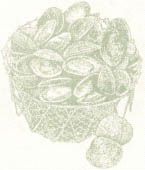
 SOFT-SHELL CRABS WITH CHERRY TOMATO SALSA
SOFT-SHELL CRABS WITH CHERRY TOMATO SALSA 
Crabs
4 jumbo soft-shell crabs, cleaned
4 cups buttermilk
2 cups flour
vegetable oil
field greens
Cherry Tomato Salsa (see below)
Cover crabs in buttermilk for at least 2 hours. Remove and dust with flour. Place shell side down in about 1 inch of preheated vegetable oil and cook for 3 minutes on each side. Remove and place on paper towels to drain. Place crabs on a bed of field greens and top with Cherry Tomato Salsa. Serves 4.
Cherry Tomato Salsa
1 pint cherry tomatoes, halved
1 red pepper, cut into thin strips
1 red onion, diced
12 scallions, sliced
½ cup red wine vinegar
2 tablespoons olive oil
2 tablespoons sugar
1 tablespoon black pepper
kosher salt to taste
Combine all ingredients in a large mixing bowl. Let stand 2 to 3 hours before serving.

US 40 EAST
FARMINGTON, PA 15437
724-329-8876
Ah, but for a twist of fate, Fayette Springs Hotel owner Andrew Stewart would have been vice president—maybe even president. Unluckily for him, Millard Fillmore was chosen as vice president instead, then succeeded to the presidency upon the death of Zachary Taylor. Stewart, a colleague of John Quincy Adams, Andrew Jackson, Martin Van Buren, and Abraham Lincoln, was known as “Old Tariff Andy” because of his legislation supporting tariffs along the National Road, which improved transportation in our young country.
Stewart built Fayette Springs Hotel in 1822 as a resort along the National Road. It boasted billiards, a tenpin alley, dancing, and top musical entertainment. After Stewart’s death in 1872, the hotel continued to be a thriving summer resort. It benefited from the spa boom of the late 1800s, since the nearby springs were believed to have curative powers.
After the Stewart family sold the hotel in the 1890s, it passed through a number of owners. George Titlow, a hotel baron and grandson of Henry Beeson, one of nearby Uniontown’s founders, purchased it in 1909 as a weekend getaway for his family. Although Titlow sold off his other hotels during Prohibition, he kept Fayette Springs Hotel until his death in 1940. The structure subsequently became known as The Stone House, as it is today. In 1954, General George C. Marshall commented about having visited The Stone House as a young man and partaking of the best Chicken and Dumplings he’d ever had.
Award-winning chef Carl Fazio came on board in 1996 with a commitment to providing guests a quality menu. Traditional items like Chicken and Dumplings and pasta dishes appear side by side with innovative choices such as Shrimp Amaretto and Seafood Celena Marie. Chef Fazio has now left The Stone House, but his tradition of quality dishes is superbly maintained by one of his protégés.
The atmosphere enjoyed by diners varies depending on where they are seated. To the left of the main hall, the tone is traditional; wood paneling, family portraits, and other framed artifacts are on the walls. Across the hall, through the arched doorway with Corinthian columns, the floral wallpaper, painted woodwork, and lace curtains create a bright, cheery dining room.
During our visit, we chatted readily with a couple at the table next to us. They recommended the Seafood Chowder, so we tried it. A good choice, it was thick and rich, a wonderful combination of potatoes, mushrooms, and various types of seafood.
Thanks to nearby attractions like Laurel Caverns and the Fort Necessity Battlefield, The Stone House is a perfect place to stop for great food while sightseeing or enjoying a scenic drive down the old National Road. And if you’re too tired to drive home, the lovely, antique-filled guest rooms upstairs can provide a welcome respite.

 SAFFRON RISOTTO WITH SHIITAKE MUSHROOMS
SAFFRON RISOTTO WITH SHIITAKE MUSHROOMS 
¼ cup shallots, diced fine
1 cup shiitake mushrooms, sliced
2 tablespoons butter
2 tablespoons olive oil
16-ounce package aborio rice (risotto)
1 cup dry white wine
pinch of saffron
8 cups chicken stock
¼ cup Parmesan cheese, grated
2 tablespoons heavy cream
Sauté shallots and mushrooms in butter and olive oil until golden. Add rice and sauté for 2 minutes. Add wine and bring to a boil. Infuse saffron into chicken stock. Begin adding chicken stock slowly to rice mixture; once rice has absorbed stock, add a little more, continuing for 10 to 15 minutes until all stock is incorporated. Add Parmesan and cream and serve. Serves 6.

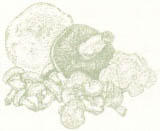
 FLANK STEAK FAJITAS
FLANK STEAK FAJITAS 
2½ pounds flank steak
2 12-ounce bottles dark beer
4 cloves garlic, sliced
2 bay leaves
1 tablespoon red pepper flakes
½ teaspoon cayenne pepper
1 tablespoon Worcestershire sauce
2 tablespoons lime juice
zest of 1 lime, grated
 cup fresh cilantro, chopped
cup fresh cilantro, chopped
 cup scallions, sliced
cup scallions, sliced
4 sprigs fresh thyme
4 sprigs fresh oregano
10 flour tortillas
2½ cups black beans, cooked
½ cup tomato salsa (favorite recipe or commercial low-sodium)
¼ cup guacamole
¼ cup sour cream
Trim steak of all visible fat. Combine next 12 ingredients for marinade; add steaks. Marinate for 48 hours. When ready to grill steaks, drain marinade and pat steaks dry. Grill over hot coals to desired doneness; remove from grill and let rest briefly before slicing thinly on the diagonal. Grill tortillas until crisp but not dry. Place ¼ cup beans on each of 10 plates and top with tortilla folded into a cone. Fill tortillas with steak and garnish with salsa, guacamole, and sour cream. Serves 10.

5005 KUTZTOWN ROAD
TEMPLE, PA 19560
610-929-4370
Perry’s Temple Hotel Restaurant is a casual eatery that is serious about food. In the twenty-plus years that Perry Cirulli has been involved with the restaurant, it has evolved from a local watering hole that was much like a tavern in appearance and approach. It’s now a restaurant known widely for its Italian cuisine, though it’s still a favorite local dinner stop. Perry expanded the menu beyond Italian cuisine to keep up with changing consumer tastes, and chef Paula Alexander has added her touch during her more than fourteen years in the kitchen.
Sauces are important here. The recipe created by Perry’s father, Asceno Cirulli, is the foundation of the restaurant’s Red Sauce. I sampled the Red Sauce in traditional fashion (over Linguine) and found it deliciously thick and robust. Perry and I discussed what else I should sample, the result being a tableful of food. The Garlic-Basil Ravioli was my choice—and I’d gladly choose it again. I gave Perry carte blanche with the rest of the menu, and he ordered a seafood entrée and the steak special. Though not typically a scallop fan, I thoroughly enjoyed the Broiled Sea Scallops. The Petite Filet was done exactly as I like it, and the accompanying Wild Mushroom Sauce was quite nice indeed. The restaurant is well known for its gourmet Cheesesteak (which I’ll have to try on another occasion) and its Roasted Hot Peppers. Perry provided me with an order of the peppers, which I took with me to share with Karen back at the hotel. They were a definite hit with both of us.
The structure that houses Perry’s Temple Hotel Restaurant dates to 1795. Originally, the building was a log-and-stone tavern called Solomon’s Temple, which had a large, colorful sign depicting King Solomon. The spot became so widely popular that the tavern lent its name to the community, which became known as Temple.
No one knows who built the original tavern, although it is a matter of record that Isaac Levan, a very wealthy gentleman, owned the hotel and the surrounding 116 acres until his death in 1800. The log-and-stone structure was replaced in 1853 during the ownership of Daniel Klechner. Between 1857 and the early 1970s, the hotel was sold eight more times, but its appearance did not radically change. Perry Cirulli’s father purchased the property in 1972.
While maintaining the historic integrity of the exterior, Perry has added beautiful hanging baskets and potted plants to the front of the hotel and lovely gardens around the rear entrance from the parking lot. Many of the herbs used in the cooking—some of which are unusual varieties that add a slightly different flavor—are grown right on the property.
Artists gather here annually to paint a variety of exterior scenes incorporating the restaurant and the gardens. Watercolors of the flowers painted over the last several years line the walls of the main dining room, allowing guests on even the snowiest of winter days to enjoy springtime at Perry’s Temple Hotel Restaurant.
 WILD HERB VINAIGRETTE
WILD HERB VINAIGRETTE 
1 clove garlic, chopped
2 pinches of salt
½ cup balsamic vinegar
salt and pepper to taste
 cup mixed herbs (basil, dill, parsley, chives, thyme, etc.), chopped fine
cup mixed herbs (basil, dill, parsley, chives, thyme, etc.), chopped fine
1 cup extra-virgin olive oil
Whisk all ingredients except olive oil in a medium bowl until well blended. To serve, combine well with olive oil and drizzle over salad. Yields approximately 1½ cups.

 VEAL SCALOPPINE WITH ASPARAGUS CREAM
VEAL SCALOPPINE WITH ASPARAGUS CREAM 
½ pound fresh asparagus
½ cup heavy cream
½ teaspoon salt
 teaspoon freshly grated nutmeg
teaspoon freshly grated nutmeg
8 2-ounce veal scaloppine
¼ cup flour
2 tablespoons butter
1 tablespoon olive oil
4 sprigs parsley for garnish
Bring 4 cups of water to a boil. Drop in asparagus and cook for 5 minutes. Drain. Reserve the prettiest tips for decoration. Place remaining asparagus, cream, salt, and nutmeg in a food processor. Process until a smooth, even sauce is obtained. Pour into a saucepan and bring to a gentle boil.
Dredge veal in flour; shake off excess. Heat butter and olive oil in a 9-inch skillet. Cook veal about 3 minutes per side until browned. Season with additional salt if desired, then transfer to a platter. Place 2 scaloppine in center of each of 4 plates. Top with reserved asparagus tips and pour sauce over top. Garnish each serving with a sprig of parsley Serves 4.

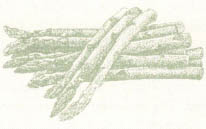
599 DORSEYVILLE ROAD
FOX CHAPEL, PA 15238
412-963-8717
Having opened its doors well over a hundred years ago, Cross Keys Inn stands along Dorseyville Road in what is now suburban Pittsburgh. In its early years, Cross Keys Hotel, as it was called then, served as a way station between Pittsburgh and Kittanning, a haven for weary travelers during their arduous forty-four-mile journey between the two towns. The inn, designated a historic landmark, has a replica of its original sign swaying in the breeze, just as that old sign must have done way back in 1850.
As travel grew more convenient and roadside inns became less necessary, Cross Keys evolved into a meeting place for area residents and the site of many energetic hoedowns. Eventually, it became a popular taproom before gradually slipping into disrepair.
After careful and authentic restoration (including overcoming the effects of a fire in the early 1990s), Cross Keys Inn again extends its welcome. The plank floors, brick walls, and lantern lights in the entry and the taproom speak to its history. The main dining room is attractively wallpapered, while the wood-paneled library just around the corner provides a cozy alternate dining area. Both rooms allow guests to enjoy a meal in a warm, traditional atmosphere. The attractively appointed upstairs dining rooms are in the old sleeping rooms. On our first visit, we dined in the centermost upstairs room, at a cozy table near the fireplace. The room was decorated with lace curtains, brass mantel accessories, and period wallpaper.
During our most recent visit, the majority of guests seemed to be known by name. As a matter of fact, we frequently heard staff members bedecked in brass Cross Keys shirt studs and cuff links asking, “The usual?”
There were more sandwich selections than we remembered from previous visits, large in size and served with Fries. The other menu selections by chef Regis McGill were creative, appealing, and pleasingly presented. The Meat Loaf, made from a mixture of three different meats, was tasty and not nearly as heavy and filling as Grandma’s higher-calorie version. The Dessert Platter, a sampling of five different dessert items, was extremely generous in size and a good choice for two dessert lovers who had difficulty making a decision.

2 8-ounce choice beef tenderloins, cut in half
salt and pepper to taste
¼ cup butter
¼ cup shallots, chopped
¼ cup cherry schnapps or cherry brandy
½ cup black cherries
½ cup veal demi-reduction or brown sauce
4 ounces Brie
Season tournedos with salt and pepper. Melt butter in a medium skillet. Add shallots and cherry liquor. Place tournedos in skillet and sauté. Add cherries and veal demi-reduction. Remove beef and place on broiler pan. Top with Brie. Place under broiler until cheese melts. Top with cherry sauce from skillet and serve. Serves 2.

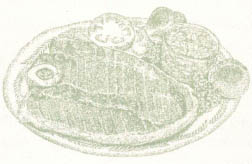
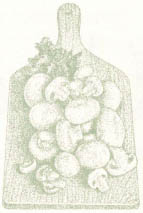
 STUFFED PORTABELLO MUSHROOM
STUFFED PORTABELLO MUSHROOM 
1 portabello mushroom
1 slice provolone cheese
4 fresh basil leaves
1 egg
¼ cup sun-dried tomato flour
¼ cup roasted red pepper strips
1 tablespoon sherry
¼ teaspoon garlic, chopped
¼ cup veal demi-reduction or brown sauce
fresh herbs
Remove stem from mushroom. Lightly steam the cap. Cut cap into half-moons. Layer cap pieces with provolone and basil. Dip in egg and then tomato flour. Lightly sauté both sides. Place in baking dish and top with pepper strips. Bake mushroom, turning until heated through. Remove from dish; drain any oil. Combine sherry, garlic, and veal demi-reduction. Spoon demi-reduction onto plate. Top with mushroom and garnish with fresh herbs of your choice. Serves 1.
